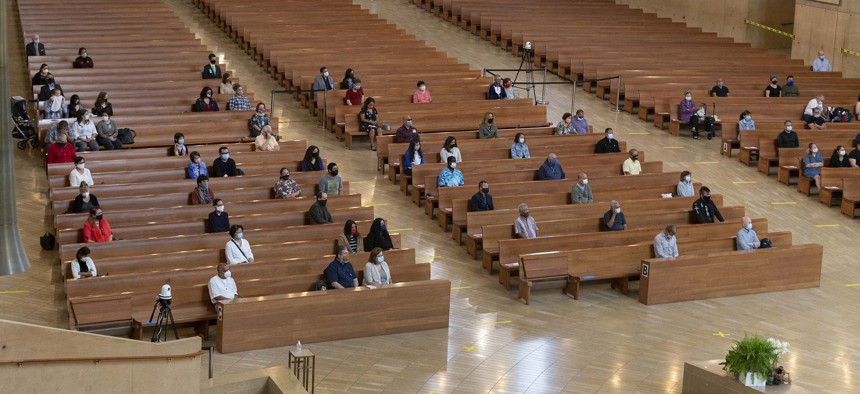Emergency Policies Curbed U.S. Virus Infections by 60 Million, Study Finds

A hundred faithful sit while minding social distancing during Mass at Cathedral of Our Lady of the Angels in Los Angeles on June 7. It was the first Mass since church services there were suspended in March due to the coronavirus outbreak. AP Photo/Damian Dovarganes

Connecting state and local government leaders
“We see when we’re losing money, what we don’t see is lives that are never lost, people that never get sick because we all took preventative action,” said a lead author of the research.
Business closures, travel restrictions and other emergency policies that governments enacted to control the spread of the coronavirus likely prevented millions of infections in the U.S., new academic research released on Monday suggests.
Researchers looked at about 1,700 local, regional and national “non-pharmaceutical” policy interventions across six different countries—including the U.S.—that were adopted to control the spread of the virus between January and April 6. These policies included measures like travel restrictions, event cancellations, school and business shutdowns and expanded paid sick leave.
The researchers estimate that, in the U.S. alone, these types of policies suppressed the number of confirmed coronavirus cases by 4.8 million and the number of total infections by 60 million. The difference between the two numbers reflects limitations with testing to confirm infections. Notably, the research only looked at infections and did not estimate how many deaths may have been prevented.
As of Monday, there were upwards of 1.9 million confirmed coronavirus cases nationwide and over 110,000 confirmed deaths from Covid-19, the respiratory disease the virus causes.
“If we hadn’t shut things down there would have been roughly 500 million more infections across just the six countries we’re looking at,” Solomon Hsiang, director of Berkeley’s Global Policy Laboratory, who led the research, said in a video recorded by the university.
“Never in human history have so many lives been saved in such a short period of time,” he added.
Restrictions to prevent the spread of the virus have exacted a heavy toll on the economy, plunging the country into a recession, leaving businesses that were forced to close their doors under extreme financial strain and contributing to a historic rise in unemployment.
At the same time, the school year was disrupted for millions of K-12 and college students across the country and people dealt with inconveniences like delays in getting non-urgent medical care.
Parts of the nation were hit hard by the virus. But the restrictive policies also affected areas with relatively few cases, a dynamic that fueled protests and led to other backlash against elected officials who deemed the measures necessary to protect public health.
The estimates from the Berkeley researchers, while just one reference point, provide some indication of what an alternative public health scenario might have looked like had the nation taken less aggressive steps with some of these types of policies that were put in place.
“We can see the pain, the economic suffering that is happening in different communities,” Hsiang said. “We see when we’re losing money, what we don’t see is lives that are never lost, people that never get sick because we all took preventative action.”
The findings come as many states are now beginning to gradually reopen their economies with new precautions in place, and as metrics show that daily hospitalizations due to the virus appear to be creeping upwards in states like Texas and North Carolina. The new peer-reviewed research on coronavirus policies was published Monday in the journal Nature. More about it can be found here.
Bill Lucia is a Senior Reporter for Route Fifty and is based in Olympia, Washington.

NEXT STORY: Americans are Gargling Bleach to Prevent Coronavirus. (It Doesn't Work.)





